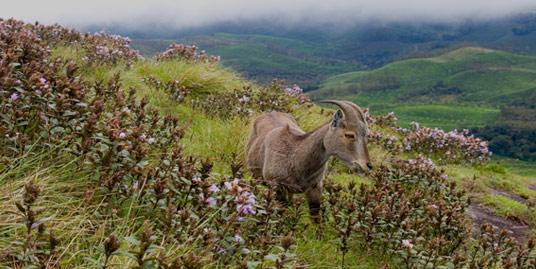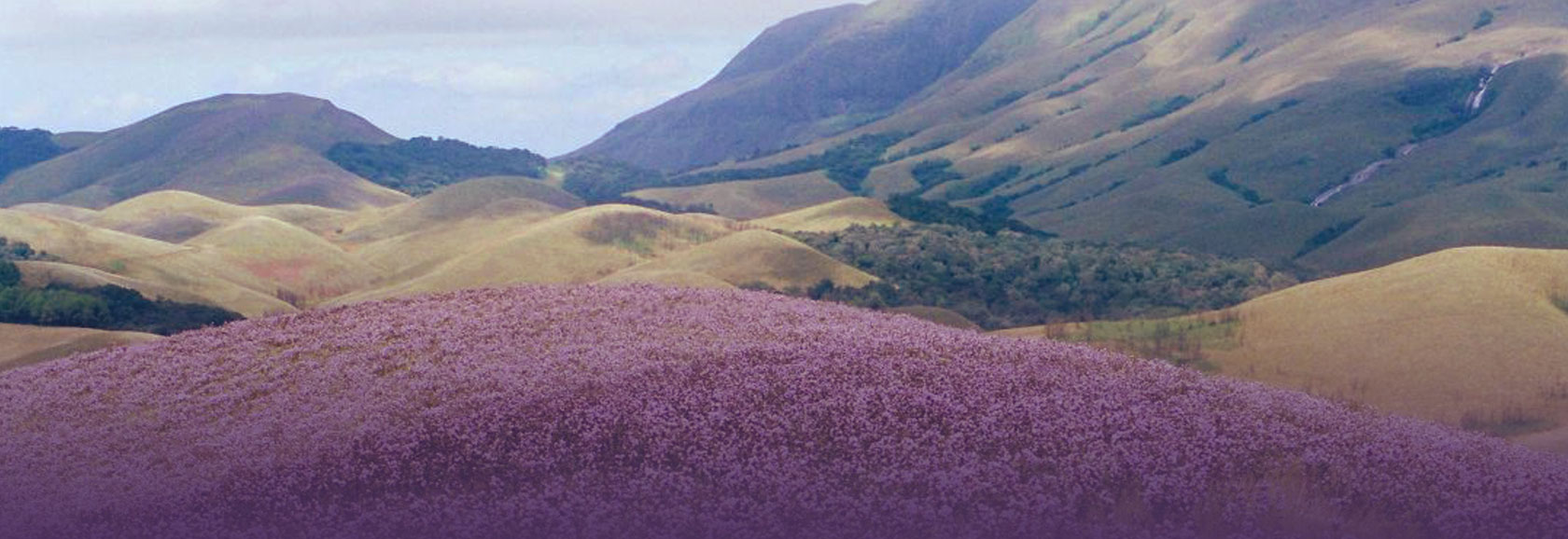

Neelakurinji – the bloom of a unique ecosystem
The bloom makes the mountains blue; We make the landscape brown?
-E Kunhikrishnan


The bloom makes the mountains blue; We make the landscape brown?
-E Kunhikrishnan

The British planters who discovered new pastures in the high altitudes of the Western Ghats soon started clearing the natural vegetation and setting up colonies. The Nilgiris was ‘discovered ‘in the early 1820s by the British administrators who decided to set up a hill station, where the top bureaucrats and army officers can have a sanatorium to escape to from the heat of the scorching sun of the Madras plains. The sholas and grasslands in the mist laden mountains were destroyed to make way for human habitation, agriculture, firewood and plantations. Robinson wrote in 1935, “It is noted by all who have seen two or three flowerings, that at each successive period, the area over which it appears becomes less and less. Every year more land in these hills is taken up and cleared for ten estates, or for fruit and vegetable culture, or for building. Many a hillside that was once blue with Strobilanthes is green with the little flat topped tea bushes, and Strobilanthes is ruthlessly exterminated as pest. It must have been a wonderful sight when first seen by a European, when there were no estates and no habitations other than the scattered hill villages, and one can only regret the loss of so much beauty.”
Several exotic trees and shrubs were introduced by European settlers. The introduction of the Australian trees eucalyptus and wattle wreaked havoc once these species established in the montane habitats, exterminating the native species. Eucalyptus globulus was introduced by about 1843 and major portion of the grasslands once blue with neelakurinji in seasons, was converted to plantations of this fast growing tree which was crucial for the tea industry and pulp based industries. Many more species of Eucalyptus were introduced to establish successful plantations. Acacia dealbeta (silver wattle), Acacia decurrens (green wattle), Acacia nearnsi i (black wattle) were introduced to the Nilgiris between 1840 and 1850. These species established very easily replacing the natural vegetation in the sholas and grasslands. The bark of the black wattle contains an alkaloid called tannin which adversely affects the growth of native plants. The vast stretches of grassland of Avalanche, Upper Bhavani, Mukurthi and Pykara were converted to black wattle plantations. The wattle, which has a terrific capacity to regenerate from the profusely produced seeds and root suckers virtually, took control of the grasslands and shola edges. Majority of the kurinji species and other endemic and rare plants described by the early botanists and naturalists vanished from the blue mountains.
The situation in the Anamalais and Kodaikanal was not different. In the year 1877, Poonjat Raja entered into an agreement with J. D. Munro and handed over about 500 square kilometres of prime forest land, including Anamudi area in Munnar. The British Planters established a huge tea plantation in the area after clearing the natural vegetation. Here also eucalyptus plantations were raised (to sustain the boilers in tea factories) which encroached into the remaining kurinji areas. The planters introduced the fast growing black wattle for quick returns in terms of firewood and timber. Till early 1980s vast stretches of montane grasslands still remained with the Department of Forest, but unfortunately, it branded these grasslands as ‘unproductive and waste’, and thus decided to convert in to black wattle plantations. Many naturalists cautioned against this type of a conversion, but authorities turned a blind eye to those arguments and never cared for the ecological importance of the montane grasslands where multitudes of endemic and rare alpine flora and fauna thrived through eons, withstanding the furies of the ice ages to mould a wonderful landscape on the roof of the mountains. Majority of the grasslands, where Strobilanthes kunthianus flowered in the 1970 and 1982 blooms were absent in 1994.
The fate of the grasslands and sholas of Kodaikanal was almost similar. Eucalyptus plantations and tea plantations were established during the late 19th century itself. Wattle was introduced to Kodaikanal in 1870, by the then Madurai District Collector Sir Vere Levenge. In Kodaikanal alone over 20000 hectares of grasslands had been converted to wattle plantations between 1950 and 1965. Pine planting was initiated and vast stretches of pine plantations were established during 1906- 1915 in the “unproductive” grasslands in Kodaikanal, with about 33 exotic species of conifers. In such plantations the floor is a thick bed of pine needles that suppress all native species that once bloomed in the area.
In the case of many plants in the kurinji landscape, it is too late to initiate any conservation measures. But one thing can be done - protect whatever remains and further encroachment into the natural habitat should be prevented. Restoration of the lost habitat should be the next step. Constructive efforts led by certain NGOs have yielded good results in Kodaikanal. In the Mukurthi National Park in Nilgiris, attempts are being made to do away with black wattle plantations, but it is very difficult to destabilise the wattle which forcefully establishes again from the root suckers and dormant seeds in the soil, especially after a fire outbreak in the grasslands.
Various Strobilanthes species found in Nilgiris ...more
There are many species of shola kurinji (locally k ...more
The first European settlers in Nilgiris recorded t ...more
The British planters who discovered new pastures i ...more
The present situation in Munnar is not giving any ...more